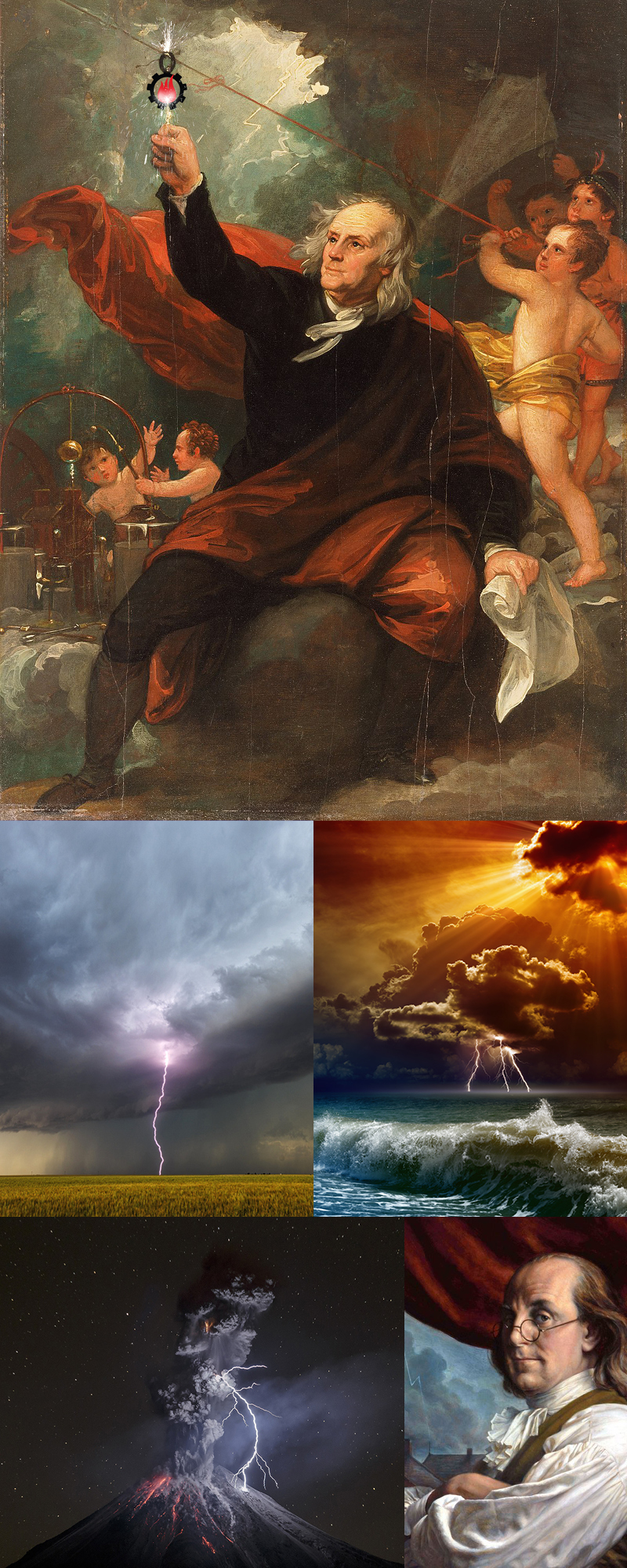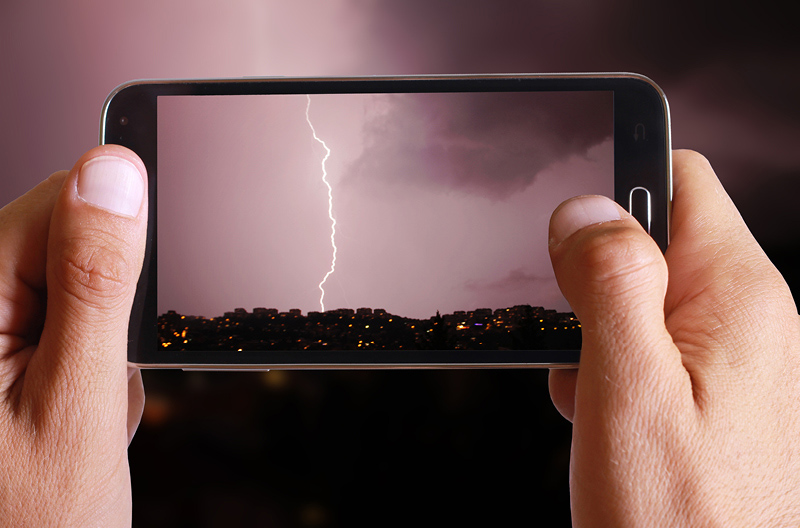Shocking

(top) This isn’t how it actually happened but it’s a pretty cool painting done around 1816 by Benjamin West (1738 – 1820) titled “Benjamin Franklin Drawing Electricity from the Sky” at the Philadelphia Museum of Art. This digital depiction embellished in 2018 by an unknown artist. 🙂 (middle left) Lightning over the great plains. (middle right) Lightning over the lake. (bottom left) Lightning in volcanos is common, too. (bottom right) Franklin was one very smart man.
With summer and warmer weather comes thunders storms. I love ‘em. From my office, I can see out across the lake, and get a real sense of when a storm is rolling in. What is most amazing from my office, is the way the storms will actually follow the Lake Erie shoreline and highway here in Cleveland. I can watch the storms literally come around the corner toward KHT! The skies darken, the wind picks up and bam, they hit – lightning -thunder and rain. It’s so cool. It got me to thinking about the story of Benjamin Franklin’s famous kite-in-a-thunderstorm experiment. I did some searching on the internet and found some fun facts and a good rendition of what happened. Enjoy, and thanks Wikipedia, The Franklin Institute and Kids Discover.com for the details. Here’s how the story goes … with some lightening trivia at the end.
On a June afternoon in 1752, (some say it was 266 years ago today, June 15th) the sky began to darken over the city of Philadelphia. As rain began to fall and lightning threatened, most of the city’s citizens surely hurried inside. But, not Benjamin Franklin. He decided it was the perfect time to go fly a kite. Franklin had been waiting for an opportunity like this. He wanted to demonstrate the electrical nature of lightning, and to do so, he needed a thunderstorm.
He had his materials at the ready: a simple kite made with a large silk handkerchief, a hemp string, and a silk string. He also had a house key, a sharp length of wire and a Leyden jar (a device designed to capture a high-voltage electric charge from an external source that’s collected between electrical conductors on the inside and outside of a glass jar. … The Leyden jar was used to conduct many early experiments in electricity, and its discovery was of fundamental importance in the study of electrostatics). His son William assisted him.
Franklin had originally planned to conduct the experiment atop a Philadelphia church spire, according to his contemporary, British scientist Joseph Priestley (who, incidentally, is credited with discovering oxygen), but he changed his plans when he realized he could achieve the same goal by using a kite.
So, Franklin and his son “took the opportunity of the first approaching thunder storm to take a walk into a field,” Priestley wrote in his account. “To demonstrate, in the completest manner possible, the sameness of the electric fluid with the matter of lightning, Dr. Franklin, astonishing as it must have appeared, contrived actually to bring lightning from the heavens, by means of an electrical kite, which he raised when a storm of thunder was perceived to be coming on.”
Despite a common misconception, Benjamin Franklin did not discover electricity during this experiment—or at all, for that matter. Electrical forces had been recognized for more than a thousand years, and scientists had worked extensively with static electricity. Franklin’s experiment demonstrated the connection between lightning and electricity.
To dispel another myth, Franklin’s kite was not struck by lightning. If it had been, he probably would have been electrocuted, experts say. Instead, the kite picked up the ambient electrical charge from the storm.
Here’s how the experiment worked: Franklin constructed a simple kite and attached a wire to the top of it to act as a lightning rod. To the bottom of the kite he attached a hemp string, and to that he attached a silk string. Why both? The hemp, wetted by the rain, would conduct an electrical charge quickly. The silk string, kept dry as it was held by Franklin in the doorway of a shed, wouldn’t.
The last piece of the puzzle was the metal key. Franklin attached it to the hemp string, and with his son’s help, got the kite aloft. Then they waited. Just as he was beginning to despair, Priestley wrote, Franklin noticed loose threads of the hemp string standing erect, “just as if they had been suspended on a common conductor.” As Franklin moved his finger near the key, the negative charges in the metal piece were attracted to the positive charges in his hand and he felt a spark.
“Struck with this promising appearance, he immediately presented his knuckle to the key, and (let the reader judge of the exquisite pleasure he must have felt at that moment) the discovery was complete. He perceived a very evident electric spark,” Priestley wrote. Using the Leyden jar, Franklin “collected electric fire very copiously,” Priestley recounted. That “electric fire”—or electricity—could then be discharged at a later time.
Franklin’s own description of the event appeared in the Pennsylvania Gazette on October 19, 1752. In it he gave instructions for re-creating the experiment, finishing with:
As soon as any of the Thunder Clouds come over the Kite, the pointed Wire will draw the Electric Fire from them, and the Kite, with all the Twine, will be electrified, and the loose Filaments of the Twine will stand out every Way, and be attracted by an approaching Finger. And when the Rain has wet the Kite and Twine, so that it can conduct the Electric Fire freely, you will find it stream out plentifully from the Key on the Approach of your Knuckle. At this Key the Phial may be charg’d; and from Electric Fire thus obtain’d, Spirits may be kindled, and all the other Electric Experiments be perform’d, which are usually done by the Help of a rubbed Glass Globe or Tube; and thereby the Sameness of the Electric Matter with that of Lightning completely demonstrated.
Could any of us imagine today the following statement… let’s go outside and play with the lightening!
Franklin wasn’t the first to demonstrate the electrical nature of lightning. A month earlier it was successfully done by Thomas-François Dalibard in northern France. And a year after Franklin’s kite experiment, Baltic physicist Georg Wilhelm Richmann attempted a similar trial but was killed when he was struck by ball lightning (a rare weather phenomenon).
After his successful demonstration, Franklin continued his work with electricity, going on to perfect his lightning rod invention. In 1753, he received the prestigious Copley Medal from the Royal Society, in recognition of his “curious experiments and observations on electricity.”
Lightening Trivia:
- A lightning bolt is about 54,000 degrees Fahrenheit — roughly five times hotter than the surface of the sun!
- Lightning flashes more than 3 million times a day worldwide — that’s about 40 times a second. Not all those flashes hit the ground — some happen between or inside clouds.
- An average lightning bolt can release enough energy to operate a 100-watt light bulb for more than three months straight (about 250 kilowatt-hours of energy).
- Lightning starts in cumulonimbus clouds — aka thunderheads — which have a positive charge up top and a negative charge below. We don’t know how the charges start, but water droplets and ice crystals carry them.
- That negative charge in the cloud creates a positive charge on Earth below, and the two charges start trying to connect and create a circuit. Ever seen electrical sparks jump across a space? It’s like that, but way bigger.
- The air between the clouds and Earth blocks the connection — until the charge gets so strong that an electrical impulse called a “stepped leader” shoots down from the cloud. The leader drops in steps of about 150 feet each at about 136,000 mph, until it almost reaches the ground. That’s when an electrical charge called a streamer rises up to meet it and complete the circuit.
- Then a bolt of electricity streaks back up along the leader’s path at about 62 million mph and creates lightning. More bolts can rise up the same path again right after. Because it all happens so fast, all we see is one bolt of lightning.
- All that energy travels along a bolt path about as wide as your thumb!
- The streamer can travel up through a building, a tree, or even a person, which can be fatal.
- Lightning kills about 2,000 people a year, so stay inside during lightning storms.
On a more optimistic note – for all of my really – really smart readers. Can anyone tell me a cost-effective way to capture all of this free electricity, and transfer it in to KHT to help run my machines? This would certainly help me cut my bills!
How to Photograph Lightning

A couple You Tube links HERE and HERE with advice for taking photos of lightning.


